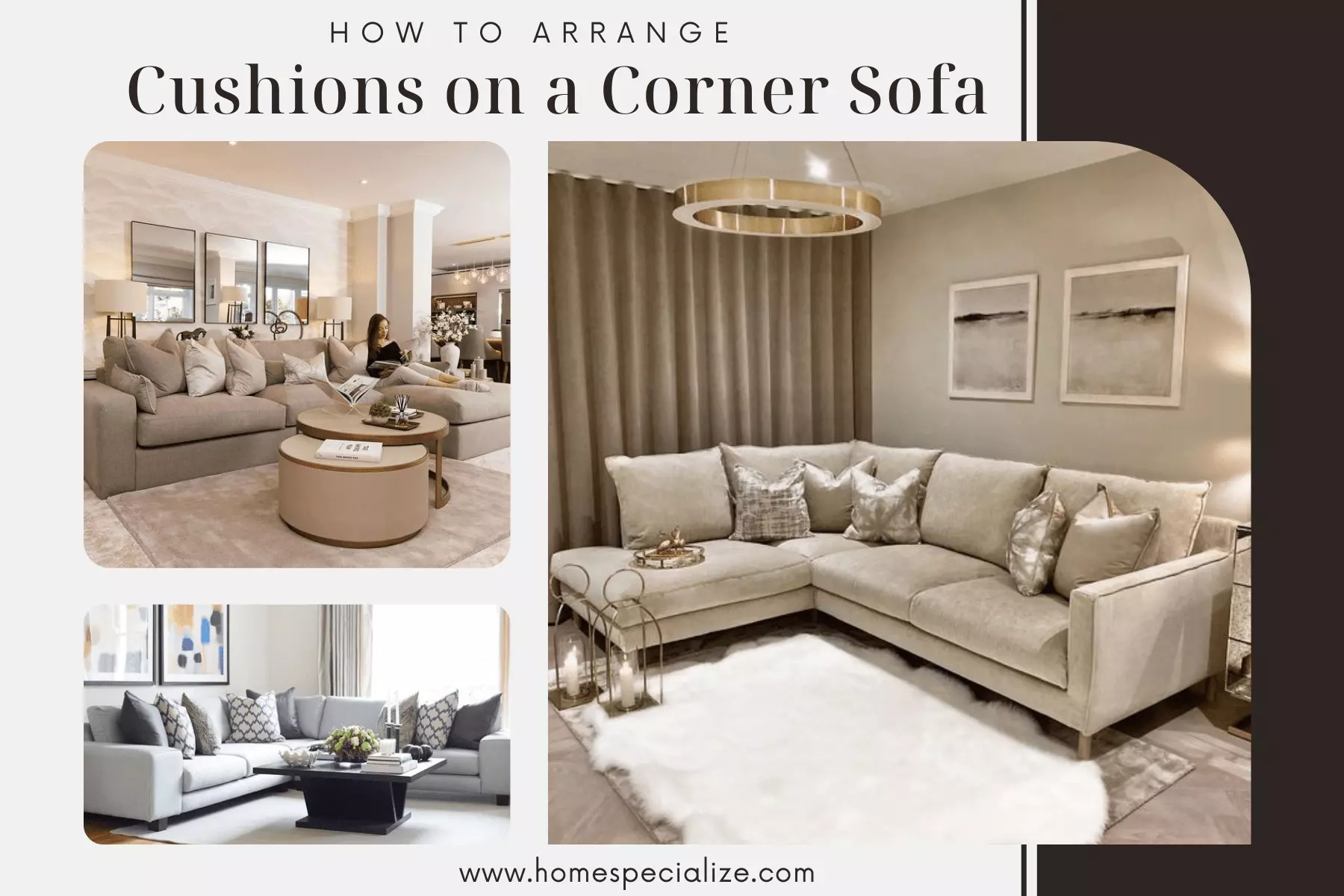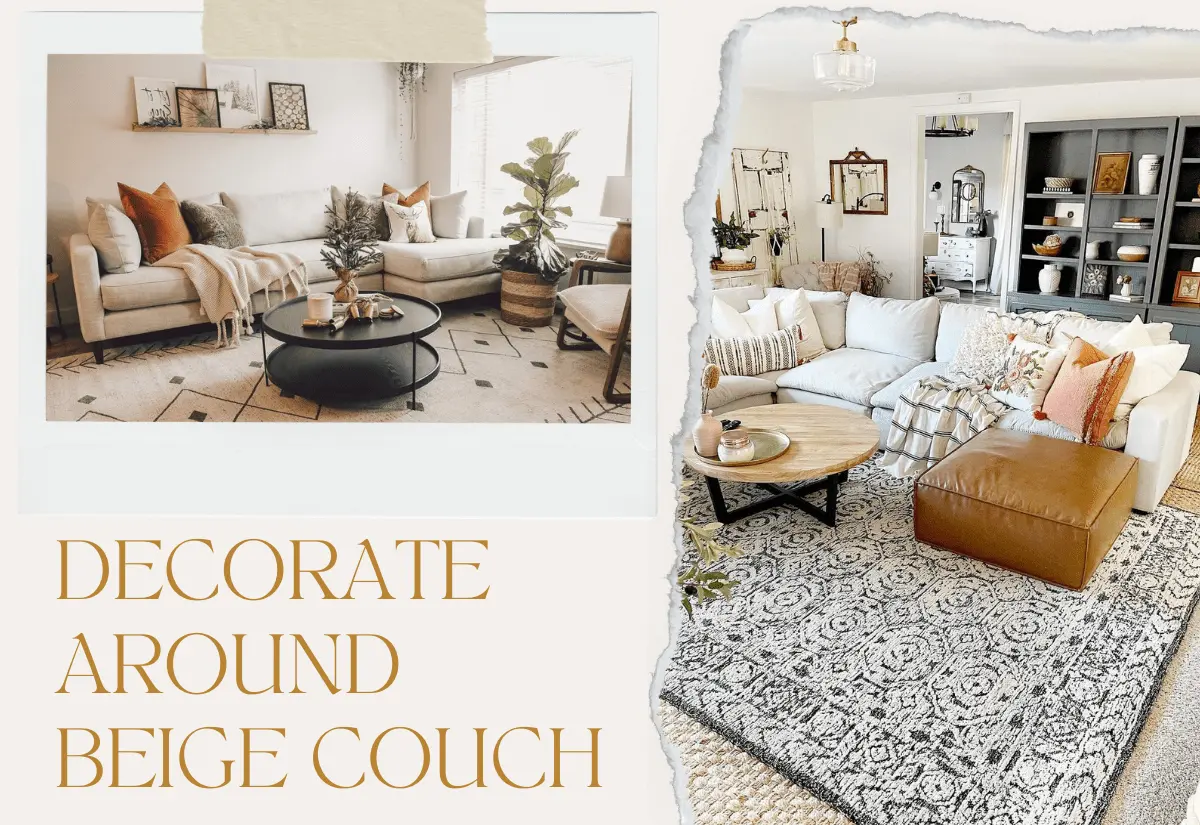Mastering how to arrange cushions on a corner sofa can elevate your living room’s ambiance, blending comfort with aesthetic flair. Begin by choosing cushions that harmonize with your sofa’s hue and texture, keeping in mind the sofa’s pivotal role in your decor.
A well-curated mix of large, medium, and small cushions introduces depth and visual interest. Embrace an odd number of cushions for a contemporary vibe, creating an asymmetrical yet pleasing arrangement. Strategically place the larger cushions at the rear to lay the foundation, progressively layering with smaller ones towards the front. Diversity in shapes is key – mix square, rectangular, and even a few round cushions for an eclectic touch.
Textures are equally important; a juxtaposition of smooth, velvety fabrics against coarser, woven ones adds a tactile dimension. Remember, while aesthetics are crucial, practicality is paramount. Your arrangement should not only captivate the eye but also offer ample space for comfortable seating and ease of movement. By following these guidelines on how to arrange cushions on a corner sofa, you’ll transform your space into a stylish and inviting nook that reflects your unique taste.
Why Choose a Corner Sofa for Your Living Room?
In my journey of interior designing, I’ve found that corner sofas are not just furniture; they are pivotal design ideas that transform a living room. Their unique shape creates an inviting central area, perfect for a cozy reading spot. As someone who loves to unwind with books and magazines, I’ve realized that these sofas offer a personal retreat within the bustling heart of the home.
Imagine a small house bustling with bigger families; space becomes a luxury. Here, a corner sofa cleverly utilizes corners, providing ample seating while keeping walkways open. It’s a smart solution to combine comfort with functionality.
Adjacent to the sofa, coffee tables emerge as statement pieces, serving not just for coffee but as a hub for social gatherings. Picture this: guests comfortably seated, some waiting, chatting, while a corner of the sofa doubles as a quiet nook for a child with a coloring book.
In my own living room, the corner sofa has seen various avatars – a lounge for meditations, a temporary spot for a yoga mat, and even as a waiting area for guests. Its versatility extends beyond just seating; it’s a canvas for creative expression.
What to Consider When Arranging Cushions
When it comes to arranging sofa cushions, my years of decorating homes have taught me a few tricks. Firstly, the size and type of sofa play a crucial role. A 2-seater corner sofa, for instance, demands a balance in the number of cushions to avoid an over the top look. It’s about creating a space that’s both stylish and comfortable.
Choosing cushions that complement your colour scheme is vital. They should not only match the sofa but also resonate with other furniture and decor pieces in the room. I often use cushions as an accent to dress up the area, adding a splash of color or texture that can entirely change the mood.
Remember, it’s not just about aesthetics; it’s about functionality too. Cushions should emanate a welcoming feel, inviting people to relax. The goal is to maximise seating comfort while enhancing the room’s overall ambiance. Every cushion placed is a statement of your personal style and the comfort of your home.
1. Create a Strong Base
In the world of cushion arranging on a corner sofa, the rule of thumb I’ve always relied on involves starting with a strong base. Typically, this involves using about 4-6 cushions, a mix of 2 large cushions, 2 medium cushions, and possibly 2 smaller accent cushions. The larger cushions should anchor either end of the sofa, while the smaller ones add depth in the middle or at the strategic corner. It’s not just about playing safe; it’s about being confident in mixing shapes, patterns, and colours. Sometimes, depending on the sofa’s size and style, you might want to experiment with more or fewer cushions for the right balance
2. Fill the Corner
When arranging cushions on a corner sofa, the corner seat often demands special attention. My approach has always been to use eye-catching cushions here, creating a visually pleasing and inviting statement. Especially when hosting guests, this spot becomes more than just a seating space; it’s a showcase of style and comfort. The key is to fill this often-overlooked void with the right filling – think soft, squishy, and ultra-cosy cushions that beckon you to relax.
3. Add Layers
Adding layers to a corner sofa is a technique I’ve often used to inject interest and depth. This involves playing with cushions of varying sizes, patterns, and textures that not only complement the room but also each other. I find that a well-placed throw on top of the arrangement not only makes it more comfortable but also adds a stylish flair. The key is to find a balance between matching and contrasting elements to create a harmonious yet dynamic look.
4. Use Patterned and Plain Cushions
A mix of patterned and plain cushions can dramatically transform the feel of a corner sofa. In my experience, relying solely on plain cushions, especially in the same colour, can make the space look a bit dull. However, introducing patterns adds charm and character. It’s about finding the right balance — the size of your sofa should guide how adventurous you get with the patterned cushions. If you’re feeling bold, opt for patterns that complement the sofa’s colour palette. This approach not only revitalizes the sofa but also the entire room.
5. Fill the Length of the Sofa
To give a corner sofa a full, plush look, I recommend filling the whole length with cushions. This technique not only utilizes the space more effectively than on a standard sofa but also offers a maximalist look. Scattering cushions along the length ensures that guests have a comfortable place to sit, lean, or snuggle. Mixing patterns and textures creates a unique yet cohesive design. This approach not only enhances the aesthetic appeal but also maximizes the functional comfort of the sofa.
6. Experiment with Bold Colours
Experimenting with bold colours in cushions can initially seem scary, but it’s a transformative approach for any home. Incorporating vibrant shades like yellow, blue, pink, or green can elevate a neutral room or a grey sofa with an unexpected pop of colour. For example, a Model 03 Teal sofa paired with orange cushions can really spice up the space. This method is about daring to step outside the comfort zone to create a lively and inviting atmosphere.
Use Cushions for Each Season
When it comes to decorating your home, especially the corner sofa, the power of cushions can’t be overlooked. They are not just comfort items but pivotal elements in setting the tone and theme of a room. As someone who loves to transform my living space with the changing seasons, I find that switching out cushion covers is a simple yet impactful way to reflect the time of year.
In the spring, I lean towards pastel hues, which bring a fresh and airy vibe, echoing the blooming outdoors. As we move into summer, more bold and vibrant colors come into play, matching the energy of summer events and the general vivacity of the season.
As the leaves turn, so does the mood of my decor. The autumnal period calls for more dark and moody tones, capturing the essence of the season. These cushions not only add a cozy feel but also prep the space for holiday seasons like Christmas, where festive cheer is paramount. I cherish the process of evolving my living space to reflect these seasonal shifts, making my corner sofa a focal point of celebration and style.
Choose a Random Mix of Cushions
In the realm of cushion arranging on a corner sofa, sometimes the best approach is to ignore traditional interior rules and do your own thing. Opting for a random mix of cushions in various colours, patterns, textures, styles, and shapes can create a carefree and eccentric vibe in your home. This method is not just about aesthetics; it’s a reflection of your personality within your decor.
From my personal experience, the joy of mixing and matching different materials and designs in cushion covers is akin to a DIY project. It’s about being happy with the result, where each swap brings a different design to the forefront. This guide isn’t just about sofa cushion replacement; it’s about embracing the joy and creativity that comes with home styling. Embracing this approach has always left me satisfied with a living space that truly represents me.
What Cushions Would Go Best for Your Corner Sofa?
Choosing the right cushions for your corner sofa hinges on the design concept and theme of your living room. When I pictured my own space, I leaned towards uniformity and consistency in the cushion setup. This doesn’t mean all cushions need to be identical; rather, they should harmonize with the room’s overall vibe. For instance, if your living room exudes a contemporary feel, sleek and minimalistic cushion designs can enhance that modernity. In a more traditional setting, cushions with classic patterns or rich textures can add depth and warmth. It’s all about creating a cohesive look that complements your corner sofa and the living room’s character.
Dimensions of the Corner Sofa
When arranging cushions on a corner sofa, the dimensions of the sofa itself should never be an oversight. It’s a crucial aspect that marries function with a sense of style. In my experience, each corner seat and its seating capacity dictate how many cushions you can sit with, ensuring both comfortable and warm snug comfort. The key is to find a balance between making your sofa efficient for seating and visually striking as a piece of interior design. Larger sofas can handle more or bigger cushions without looking overcrowded, while smaller ones benefit from fewer, well-placed cushions to avoid a cramped appearance. This thoughtful consideration ensures that your corner sofa remains both a comfy haven and a stylish focal point in your home.
Colour Combination
The theme and colour palette of your corner sofa cushion arrangement should be a harmonious blend of hues, patterns, and textures, maintaining consistency both on a macro and micro level. In my journey of decorating, I’ve learned that the living room’s atmosphere and mood are significantly influenced by these choices. The corner sofa, often the centerpiece, can dictate the room’s aura. Selecting a range of colours and shades for the cushions requires a perceptive eye to harmonize with the overall decor, stirring desired emotions and sensations. This isn’t just about aesthetic appeal; it’s about creating a space that resonates with your personal style and brings comfort to all who enter.
Lear More: What Colour Cushions Go with a Black Sofa
Size and Shape of Cushions
For your corner sofa, the size and shape of cushions play a pivotal role. A creative mix and match of different sizes, from large to regular-sized, can create a coherent look even without equal sizes. The shapes of cushions offer unique visual plays that enhance both comfort and space aesthetics. For instance, incorporating circular, bolster, or lumbar tube shapes can inject an eccentric vibe. Conversely, sticking to identical forms might suit a more minimalist mood. In a traditional setting, positioning smaller cushions in front of larger ones ensures a proportionate look that aligns with the seating capacity of the corner sofa. This method has always worked wonders in my home, creating an inviting and stylish corner nook.
Cosiness
When we think about enjoying our corner sofa, cushions play a significant role in providing support and relaxation while sitting or snuggling. A lesser-known fact is that these soft accents add both character and style to the space, being a huge part of creating a cozy and inviting vibe. Especially in the corner seats, where comfort is paramount, choosing the right cushions is essential. In my journey of designing and redesigning my living room, I’ve found that plush, soft cushions transform the corner sofa into a haven of comfort, encouraging relaxation and a sense of well-being.
FAQ’S:
How Do You Rearrange a Corner Sofa?
Rearranging a corner sofa effectively means considering it as a section of the space, almost like drawing an invisible line between dining and living space. I found that placing the corner sofa in the middle of these areas creates a clear divide, yet allows for easy mingling. For instance, positioning it near a wall but still central enough ensures that it’s a focal point while also facilitating movement. This setup particularly shines during gatherings, where the sofa becomes a hub for guests, with a clear view of the eye and easy access to drinks and snacks from the kitchen. It’s a practical yet inviting way to define and utilize your living space.
How Can I Make My Corner Sofa Look Better?
Enhancing the look of an L-shaped sofa, especially in a rustic setting, involves more than just the sofa itself. Pairing it with a textured rug beneath not only accentuates the sofa’s curves but also draws attention to the corner. Placing rectangles or a square coffee table in proximity considers the dimensions and flow of the overall décor. For a dark sofa fabric, adding a floor lamp to one side can lighten up the space, creating a balanced and inviting ambiance. This approach has always brought a cohesive and refined look to my living space, making the corner sofa a standout feature.
How Should Cushions Be Arranged on a Sofa?
There isn’t a hard-and-fast rule to arrange cushions on a sofa, but a 2-1-2 arrangement is popular and visually appealing. This involves placing a large cushion at each corner and a smaller cushion in the centre, creating symmetry and balance. In my own home, this layout not only enhances the sofa’s look but also ensures comfort for anyone sitting. This method works exceptionally well for corner sofas, where the arrangement draws the eye along the length of the sofa, making it a focal point in the room.
Need more information about Sofa look here, And visit our website for more home related information Homespecialize





